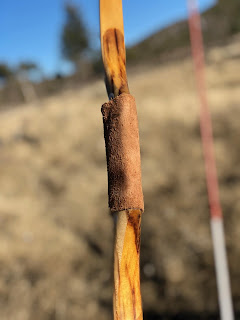A diversion to look at bows and quivers
Sometimes all this technical talk can get too much and we have to stop and sit back and just enjoy the Hill-style bows and accoutrements that appeal to us...part of the reasons why we enjoy shooting with such tackle. Here's a little digression to show a sampling of the Hill-style ASL longbows I make, per inspiration and instruction by John Schulz and also the Hill style of backquivers as Hill showed the Schulz family.
All the longbows are glassed face and back. The stacked bamboo handles of which Hill liked to make and used in his early bows with the convex concave limb construction, were first made by me in 2009 and made public for sale in 2010. At that time, there was no other bowyer making a glassed bow with that style of handle, reminiscent of Hill's personal bows. This bow handle construction style became popular by requests to other bowmakers and now is offered as an option by most ASL bowyers.
The longbows pictured with exposed radius fadeouts under glass were my exclusive offering to the market starting in 2011. At that time no one was building a glass faced bow with visible, radius fadeouts. Since then, other bowmakers have built bows with exposed fadeouts that are square cut, or used other methods to duplicate the look such as riser overlays or long gently sloping fadeouts. This process of radius fadeouts is difficult to do, especially with a short handle Hill style longbow. To date, I have seen no other bowmaker combining a short riser per Hill, with radius fadeouts under clear glass, and that is mostly due to the process of bowmaking that most bowyers employ, which is different than the multi step process that Hill originally developed and which I used for the majority of my bowmaking process. Anyway, have a look. I'm not currently taking any bow orders, but am taking quiver orders, via contacting me through email listed in my profile on this blog home page.
















Woeee! Some nice looking equipment there
ReplyDeleteThere certainly is a beauty to that simple design though complex in detail
Beautiful stuff Nate! I can't wait to get my back quiver from you and you can bet I'll be one of the first in line if you start taking bow orders again.
ReplyDeleteLots of beauty in the photos above! The visible fadeouts were one of the things that originally attracted me to the "natural" ASL's. No less gorgeous under good quality glass.
ReplyDeleteAwesome, love my Sunset Hill
ReplyDeleteAll great looking bows Nate, as always. Since we are on the topic of fadeouts, am I correct in assuming that you believe that a radiused fadeout is structurally important to the bow in some way, or is it simply a more aesthetically pleasing (which it most definately is) result of the method of construction?
ReplyDeleteWith a deep core Hill style bow and no belly glass, the radius fadeouts are a little stronger against compression and are also the result of the deep limb and trapping. With belly glass, these radius fadeouts are cosmetic
ReplyDeleteWow, beautiful bows and quivers! I'll be sending an email shortly to request a quiver, and do hope that you'll start taking bow orders sometime soon. In the meantime I'll work on my shooting with my d/r longbow and long static recurves per the system you lay out here.
ReplyDeleteBeautiful work Nate. I would love to see pics of your building process and forms. I would love to have one of your bows some day. Heirloom pieces for sure.
ReplyDeleteIs that antler side plate or elk ivory? Is there a glass strip in the core too? Absolutely beautiful craftsmanship sir! I would love to own one of your bows some day. Keep yo the good work and this blog.
ReplyDeleteThese photos show elk antler, but I also use moose antler. Yes, that is a core glass
ReplyDelete